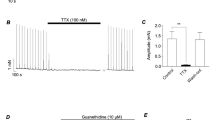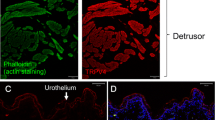Abstract
The effects of the putative gap junction blocker carbenoxolone on smooth muscle syncytial properties and junction potentials were studied in guinea pig vas deferens (GPVD). Treatment with 50 μM carbenoxolone reversibly and significantly increased input resistance (R in) (by 682.5 ± 326.0 %, P < 0.05) and abolished cable potentials within 6–7 mins of incubation, without disturbing resting membrane potential. Carbenoxolone reversibly and significantly increased the amplitude of spontaneous excitatory junction potentials (sEJPs) by 96.9 ± 35.45% (P < 0.05), shifted their amplitude distribution rightwards, and reduced their frequency of occurrence by 58.17 ± 17.7% (P < 0.05), without altering their time courses. Similarly, carbenoxolone increased the amplitude of evoked excitatory junction potentials (eEJPs) by 17.7 ± 5.88% and τ decay by 19.43 ± 8.29% (P < 0.05). Our results indicate that carbenoxolone alters the electrical properties and junctional potentials of the GPVD by a mechanism consistent with a relatively specific block of gap junctions. These results suggest that gap junction mediated cell-to-cell communication may significantly modulate the electrical properties and junctional potentials of the GPVD and consequently the physiological functioning of this tissue.


Similar content being viewed by others
References
Abe Y, Tomita T (1968) Cable properties of smooth muscle. J Physiol 196:87–100
Bennett MR (1967) The effect of intracellular current pulses in smooth muscle cells of the guinea-pig vas deferens at rest and during neurotransmission. J Gen Physiol 50:2459–2470
Bennett MR, Gibson WG (1995) On the contribution of quantal secretion from close-contact and loose-contact varicosities to the synaptic potentials in the vas deferens. Philos Trans R Soc Lond B Biol Sci 347:187–204
Bennett MR, Gibson WG, Poznanski RR (1993) Extracellular current flow and potential during quantal transmission from varicosities in a smooth muscle syncytium. Philos Trans R Soc Lond B Biol Sci 342:89–99
Bywater RA, Taylor GS (1980) The passive membrane properties and excitatory junction potentials of the guinea pig deferens. J Physiol 300:303–316
Cunnane TC, Manchanda R (1990) On the factors which determine the time-courses of junction potentials in the guinea-pig vas deferens. Neurosci 37:507–516
Cunnane TC, Stjarne L (1984) Transmitter secretion from individual varicosities of guinea-pig and mouse vas deferens: highly intermittent and monoquantal. Neurosci 13:1–20
Fanchaouy M, Serir K, Meister JJ, Beny JL, Bychkov R (2005) Intercellular communication: role of gap junctions in establishing the pattern of ATP-elicited Ca2+ oscillations and Ca2+-dependent currents in freshly isolated aortic smooth muscle cells. Cell Calcium 37:25–34
Gareri P, Condorelli D, Belluardo N, Gratteri S, Ferreri G, Donato Di Paola E, De Sarro A, De Sarro G (2004) Influence of carbenoxolone on the anticonvulsant efficacy of conventional antiepileptic drugs against audiogenic seizures in DBA/2 mice. Eur J Pharmacol 484:49–56
Garfield RE, Thilander G, Blennerhassett MG, Sakai N (1992) Are gap junctions necessary for cell-to-cell coupling of smooth muscle?: an update. Can J Physiol Pharmacol 70:481–490
Ghildyal P, Palani D, Manchanda R (2006) Post- and pre-junctional consequences of ecto-ATPase inhibition: electrical and contractile studies in guinea-pig vas deferens. J Physiol 575:469–480
Holman ME, Taylor GS, Tomita T (1977) Some properties of the smooth muscle of mouse vas deferens. J Physiol 266:751–764
Manchanda R (1995) Membrane current and potential change during neurotransmission in smooth muscle. Curr Sci 69:140–150
Manchanda R, Venkateswarlu K (1997) Effects of heptanol on electrical activity in the guinea-pig vas deferens. Br J Pharmacol 120:367–370
Manchanda R, Venkateswarlu K (1999) Quantal evoked depolarizations underlying the excitatory junction potential of the guinea-pig isolated vas deferens. J Physiol 15:527–537
Manchanda R, Venkateswarlu K, Sumedha Y (1998) Quantal depolarizations at the cellular and molecular level in smooth muscle. Current Sci 75:470–477
Merrillees NC (1968) The nervous environment of individual smooth muscle cells of the guinea pig vas deferens. J Cell Biol 37:794–817
Merrillees NC, Burnstock G, Holman ME (1963) Correlation of fine structure and physiology of the innervation of smooth muscle in the guinea pig vas deferens. J Cell Biol 19:529–550
Nakazawa K, Matsuki N, Shigenobu K, Kasuya Y (1987) Contractile response and electrophysiological properties in enzymatically dispersed smooth muscle cells of rat vas deferens. Pflügers Archiv 408:112–119
Perez Velazquez JL, Kokarovtseva L, Sarbaziha R, Jeyapalan Z, Leshchenko Y (2006) Role of gap junctional coupling in astrocytic networks in the determination of global ischaemia-induced oxidative stress and hippocampal damage. Eur J Neurosci 23:1–10
Placantonakis DG, Bukovsky AA, Aicher SA, Kiem HP, Welsh JP (2006) Continuous electrical oscillations emerge from a coupled network: a study of the inferior olive using lentiviral knockdown of connexin36. J Neurosci 26:5008–5016
Pointis G, Fiorini C, Defamie N, Segretain D (2005) Gap junctional communication in the male reproductive system. Biochim Biophys Acta 1719:102–116
Purves RD (1976) Current flow and potential in a three-dimensional syncytium. J Theor Biol 60:147–162
Rozental R, Srinivas M, Spray DC (2001) How to close a gap junction channel. Efficacies and potencies of uncoupling agents. Methods Mol Biol 154:447–476
Sourav S, Manchanda R (2000) Influence of the size of syncytial units on synaptic potentials in smooth muscle. Med Biol Eng Comput 38:356–359
Sourav S, Manchanda R (2001) Effects of variation in intercellular electrical coupling on synaptic potentials in smooth muscle: a computational study. Elec Magnetobiol 20:193–205
Takano H, Dora KA, Garland CJ (2005) Spreading vasodilatation in resistance arteries. J Smooth Muscle Res 41:303–311
Tomita T (1975) Electrophysiology of mammalian smooth muscle. Prog Biophys Mol Biol 30:185–203
Turale N, Devulapalli A, Manchanda R, Moudgalya K, Sivakumar G (2003) Simulation framework for electrophysiological networks: effect of syncytial properties on smooth-muscle synaptic potentials. Med Biol Eng Comput 41:589–594
Acknowledgements
We acknowledge financial support provided by the Department of Science & Technology (DST), India (SP/SO/B-11/2000), and by IIT-Bombay under the Cross Disciplinary Research Grant. We would like to express special thanks to Swati Gawade, School of Biosciences and Bioengineering, IIT-B for her able assistance with data analysis.
Author information
Authors and Affiliations
Corresponding author
Rights and permissions
About this article
Cite this article
Palani, D., Ghildyal, P. & Manchanda, R. Effects of carbenoxolone on syncytial electrical properties and junction potentials of guinea-pig vas deferens. Naunyn-Schmied Arch Pharmacol 374, 207–214 (2006). https://doi.org/10.1007/s00210-006-0109-7
Received:
Accepted:
Published:
Issue Date:
DOI: https://doi.org/10.1007/s00210-006-0109-7




